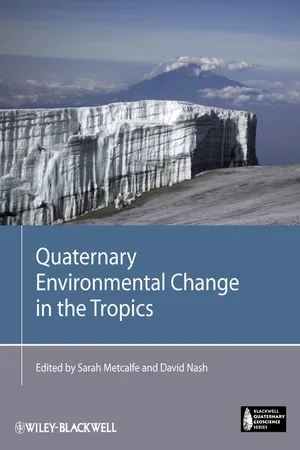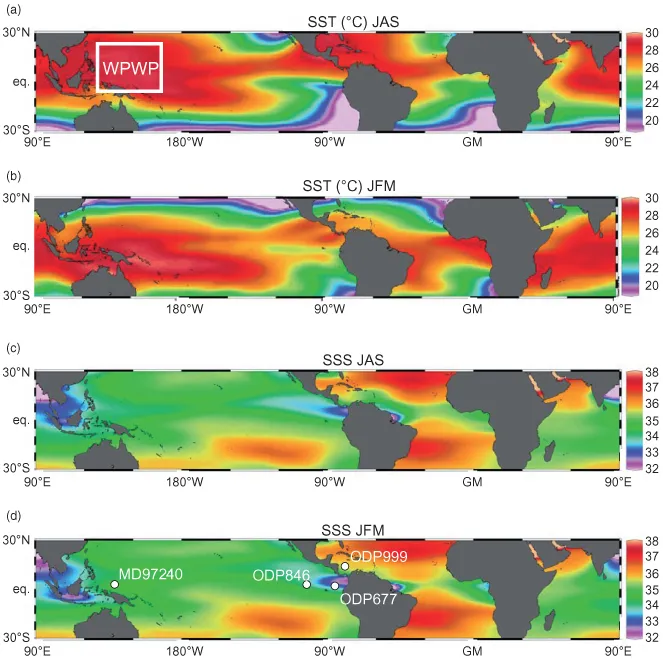![]() II
II
Regional Environmental Change![]()
CHAPTER 3
Tropical Oceans
Jan-Berend W. Stuut, Matthias Prange, Ute Merkel and Silke Steph
3.1 Tropical Oceans in the Global Climate System
The tropical oceans have long been recognised as a key player in global climate as the large gradients in the global heat distribution require strong poleward heat transport out of the tropics through both atmospheric and oceanic processes. A number of oceanic processes make the tropics highly effective in this heat transport; for example the entrainment (upwelling) of cold subsurface waters into the surface layer, which enables the equatorial ocean to absorb atmospheric heat input, and the following transport of these surface waters to the higher latitudes. This process is considered the main balance against the deep-water formation near the poles (e.g. Csanady, 1984). During the past few decades there has been increasing interest in the tropical oceans and their role in global climate throughout the geologic past. As a result, many scientific oceanic expeditions were initiated to study deep-sea sediments, which are thought to have registered such changes in their fossil and sediment content. A number of proxies for oceanic conditions were developed, which will be discussed in section 3.2. As sedimentation rates determine the resolution of the sediment record, deep-sea sediments from the central equatorial basins were used to reconstruct palaeo-oceanographic conditions on longer timescales (millions of years), and records from areas of high-sedimentation rates (e.g. Amazon and Congo fans) were used for the higher resolved and shorter time spans.
To explore the role of the tropical oceans in global climate we start with the present-day situation in terms of energy balance and consequent oceanic conditions (section 3.1.1) and modern climatologic characteristics like El Niño (3.1.2), forcing factors leading to the observed variability between the ocean basins (3.1.3), the monsoon system (3.1.4) and the role of tropical oceans in the global-ocean circulation (3.1.5). In section 3.2 we discuss the tools currently available to reconstruct palaeoenvironmental conditions, and continue with the state-of-the-art reconstructions of Quaternary climate starting on a glacial–interglacial scale (3.3.1), carrying on with the early Quaternary (3.3.2), through the Mid-Pleistocene Transition (3.3.3) into the late Quaternary (3.3.4), the Last Glacial (3.4.1), the Last Termination (3.4.2) with specific attention for the development of ENSO (3.4.3) and finally the Holocene (3.4.4). The chapter concludes with an outlook of what we have learned from the Quaternary variability in light of future climate scenarios.
3.1.1 Modern Climatology
Due to the high amount of solar energy that is received at the low latitudes (see Chapter 1, section 1.1) the upper layer of the tropical oceans is heated, and due to the resulting evaporation its salinity increases (Fig. 3.1). This causes stratification of the tropical ocean with a warm and salty top layer that mixes poorly with the underlying cold deep water. Through the immense energy transfers that take place in the tropical oceans they serve as a heat engine for Earth’s climate and as a major moisture source for the Earth’s hydrological cycle (Quinn et al., 2006).
As a consequence of such stratification, tropical ocean circulation is primarily in horizontal directions. Following the simplified global ocean conveyor model (Broecker, et al., 1985; see section 3.1.5), net horizontal transport in the tropical Atlantic and Pacific Oceans is northward, while deep waters move southward. The limited vertical exchange that does take place within the low-latitude oceans occurs predominantly in so-called upwelling cells along the eastern continental margins of the Atlantic (e.g. Darbyshire, 1966) and Pacific oceans (e.g. Longhurst, 1967), where denser, colder and nutrient-rich central/mode waters (formed outside the tropics) come to the surface. Upwelling, however, is not restricted to eastern boundary regions. The trade winds induce a transport of water within the wind-driven Ekman layer. Due to the influence of the Coriolis force, the Ekman transport is directed to the right (left) of the surface wind in the Northern (Southern) Hemisphere. This poleward movement of surface waters has to be compensated for by equatorial upwelling bringing cold waters to the surface. This phenomenon is particularly important in the tropical Pacific where a prominent cold tongue of surface waters extends from South America almost to the international dateline, but it is also found in the equatorial Atlantic (e.g. Mitchell and Wallace, 1992; Christian and Murtugudde, 2003). The tropical Pacific and Atlantic mean states are thus characterised by a pronounced east–west gradient in surface and subsurface ocean temperatures. In contrast, there is no evidence of equatorial upwelling in the Indian Ocean (Knauss and Taft, 1963; Tomczak and Godfrey, 2001).
The present-day distribution of sea-surface temperatures (SSTs) in the tropical oceans shows a moderate seasonal variability (Fig. 3.1) with average temperatures of about 18–33 °C. The upwelling areas on the eastern sides of the ocean basins, characterised by low SSTs particularly in Northern Hemisphere summer south of the Equator, are clearly visible. Another striking feature is the lack of seasonal SST variability around the Indonesian archipelago: SSTs are year-round warmer than 28 °C. Because of these continuously high temperatures, the region is called the Western Pacific Warm Pool (WPWP), which contributes explicitly to the global heat engine (e.g. Quinn et al., 2006).
The sea surface salinity (SSS) map of the tropical oceans (Fig. 3.1) illustrates that despite the high SSTs, the WPWP is characterised by relatively fresh waters, resulting from excessive tropical rainfall and river runoff in this area. Moreover, freshwater plumes are visible off major rivers including the Ganges-Brahmaputra in East Asia, the Niger and Congo in Africa, and the Amazon in northeastern South America. The low-salinity pool in the tropical eastern Pacific can be attributed to atmospheric moisture fluxes from the Atlantic to the Pacific across the Central American Isthmus as well as to westerly moisture transport from the central Pacific to the Panama Bight (e.g. Prange et al., 2010). Extremely high salinities are observed in semi-enclosed basins like the Red Sea and Arabian Gulf, where evaporation is high (>5 m/a) and river runoff is limited.
Upwelling of cold subsurface waters on the eastern side of the oceans is primarily driven by tropical trade winds that drive a westward flow of warm surface waters. As a consequence, these warm waters pile up against the eastern margins of the continents on the western sides of the Pacific and Atlantic Oceans. In the Indian Ocean the reverse is observed; SSTs at the western side of the basin are lower than those in the east, which is due to the strong seasonal monsoon-driven upwelling along the east African coast (e.g. Webster et al., 1999). Upwelling of cold and nutrient-rich subsurface waters boost the primary productivity in these areas and, as a consequence, past variability in upwelling intensity and hence the strength of the monsoon is often reconstructed from past variability in primary productivity (e.g. Schulz et al., 1998; Beaufort et al., 2001; Wang et al., 2005).
The performance of state-of-the-art general circulation models of the coupled ocean–atmosphere system in representing the tropical oceans’ mean state and variability has been addressed in several international projects. Whilst the El Niño Simulation Intercomparison Project (ENSIP; Latif et al., 2001) focused on the tropical Pacific, all tropical oceans were addressed in the Study of Tropical Oceans In Coupled General Circulation Models (STOIC) project (Davey et al., 2002). These studies demonstrate the ability of general circulation models to represent interannual variability, but also document the shortcomings in simulating correctly the ocean mean state, such as the zonal SST distribution in equatorial regions. More recent studies, such as the detailed intercomparison by Guilyardi (2006), emphasise the progress of a significant number of general circulation models in correctly reproducing the main features of equatorial climate, in particular SST.
3.1.2 El Niño–Southern Oscillation and its Relatives
Tropical Pacific variability is mostly explained by the annual cycle and the interannual variations related to the El Niño–Southern Oscillation (ENSO, see also Chapter 2, section 2.5.1, and Chapter 9, section 9.4.1). ENSO is the most prominent phenomenon of interannual climate variability. During El Niño episodes, the upwelling of cold and nutrient-rich water in the eastern tropical Pacific is strongly reduced. This leads to a large-scale warming of the upper layers of the tropical Pacific, with considerable SST anomalies of up to 5 °C near the west coast of South America. By contrast, La Niña episodes exhibit anomalously low ocean surface temperatures due to enhanced equatorial and coastal upwelling in the eastern Pacific. ENSO is a prominent example of the close interaction between the ocean and the atmosphere. Coupled to SST variations, the contrast in sea-level pressure across the tropical Pacific also exhibits temporal variations (‘Southern Oscillation’), which become manifest in the strength of the trade winds. During El Niño, the trade winds are weakened, whereas during La Niña, an intensification of the trade winds is observed. The positive ocean–atmosphere feedback during the development of an El Niño (La Niña) event was first described by Bjerknes (1969). It should be noted that the observed distribution of SST anomalies (e.g. for the widely used Niño-3 diagnostic, a box-average for the eastern tropical Pacific; 150 °W–90 °W, 5 °S–5 °N) is skewed towards El Niño events, that is warm events tend to exhibit a stronger amplitude than cold events (see Trenberth, 1997).
The ENSO phenomenon induces a major reorganisation of the atmospheric circulation. The major convection zones are shifted from the WPWP towards the east; Indonesia and northern Australia usually experience a substantial decrease in precipitation while wetter conditions are observed over western South America. As noted by Tribbia (1991), however, the oceanic ENSO changes and the concomitant reorganisation of the atmospheric circulation exhibit a clear disparity in scale. Via teleconnections, the tropical Pacific anomalies are communicated to regions beyond the tropical Pacific realm (Trenberth et al., 1998; Alexander et al., 2002). These provide the ENSO phenomenon with a socio-economic dimension (Pielke Jr. and Landsea, 1999; Laosuthi and Selover, 2007) through the impacts on fishery along the South American coast, on the pricing of agricultural products (e.g. coconut oil, rice), and on national economies through damage induced by Atlantic hurricanes which are found to be more frequent during La Niña seasons (Pielke Jr. and Landsea, 1999). Therefore, an accurate prediction of ENSO is not only of scientific interest but also of economic and political relevance. Much progress has been achieved in predicting ENSO through the setup of the observational TOGA/TAO buoy array in the tropical Pacific and altimeter data of sea-level height becoming available from satellites, and through the assimilation of these products into seasonal forecasting systems which leads to considerably better forecasting skill (Latif et al., 1998).
In addition to the annual cycle and ENSO, there is also evidence that sub-ENSO variability on timescales of 1–2 years provides a significant contribution to tropical Pacific variability (e.g. Jin et al., 2003; Keenlyside et al., 2007). On longer timescales, ENSO may also be modulated by the subtropical north and south Pacific oceans or exhibit a coupling to mid latitude decadal variability (Trenberth and Hurrell, 1994; Schneider et al., 1999; Matei et al., 2008).
Tropical Atlantic interannual variability is mostly described by two modes. The equatorial mode (Zebiak, 1993) bears some resemblance to its Pacific counterpart, ENSO. Furthermore, a meridional mode (Chang et al., 1997; Servain et al., 1999), which involves meridional displacements of the Intertropical Convergence Zone (ITCZ) and an interhemispheric gradient of S...

